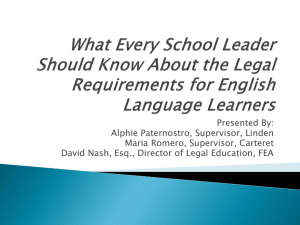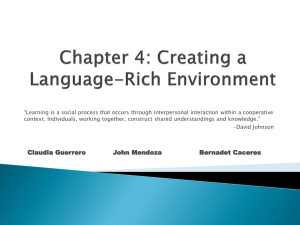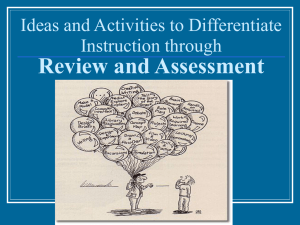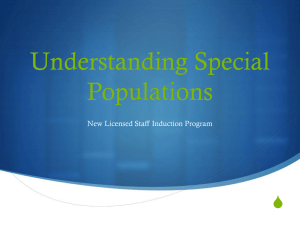Sherwood Plan - Oregon Department of Education
advertisement
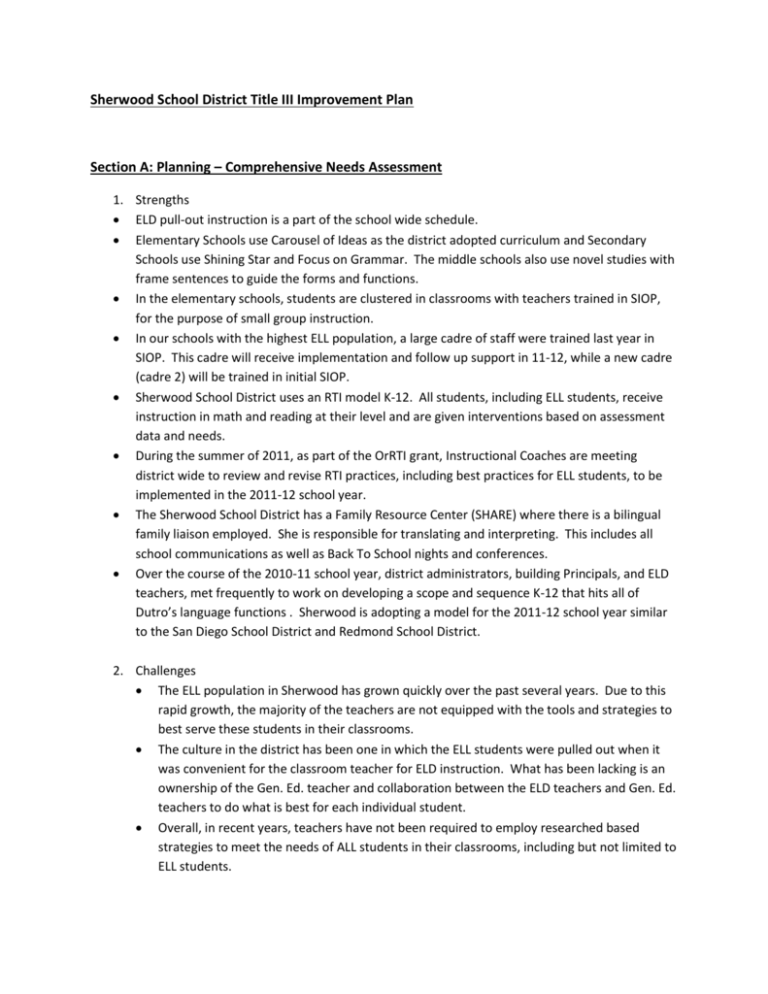
Sherwood School District Title III Improvement Plan Section A: Planning – Comprehensive Needs Assessment 1. Strengths ELD pull-out instruction is a part of the school wide schedule. Elementary Schools use Carousel of Ideas as the district adopted curriculum and Secondary Schools use Shining Star and Focus on Grammar. The middle schools also use novel studies with frame sentences to guide the forms and functions. In the elementary schools, students are clustered in classrooms with teachers trained in SIOP, for the purpose of small group instruction. In our schools with the highest ELL population, a large cadre of staff were trained last year in SIOP. This cadre will receive implementation and follow up support in 11-12, while a new cadre (cadre 2) will be trained in initial SIOP. Sherwood School District uses an RTI model K-12. All students, including ELL students, receive instruction in math and reading at their level and are given interventions based on assessment data and needs. During the summer of 2011, as part of the OrRTI grant, Instructional Coaches are meeting district wide to review and revise RTI practices, including best practices for ELL students, to be implemented in the 2011-12 school year. The Sherwood School District has a Family Resource Center (SHARE) where there is a bilingual family liaison employed. She is responsible for translating and interpreting. This includes all school communications as well as Back To School nights and conferences. Over the course of the 2010-11 school year, district administrators, building Principals, and ELD teachers, met frequently to work on developing a scope and sequence K-12 that hits all of Dutro’s language functions . Sherwood is adopting a model for the 2011-12 school year similar to the San Diego School District and Redmond School District. 2. Challenges The ELL population in Sherwood has grown quickly over the past several years. Due to this rapid growth, the majority of the teachers are not equipped with the tools and strategies to best serve these students in their classrooms. The culture in the district has been one in which the ELL students were pulled out when it was convenient for the classroom teacher for ELD instruction. What has been lacking is an ownership of the Gen. Ed. teacher and collaboration between the ELD teachers and Gen. Ed. teachers to do what is best for each individual student. Overall, in recent years, teachers have not been required to employ researched based strategies to meet the needs of ALL students in their classrooms, including but not limited to ELL students. While the district has adopted research based curriculum (Carousel of Ideas, Focus on Grammar, and Shining Star), ELL teachers are not using these curricula with fidelity nor have they been consistently hitting all language functions throughout the year. This is due, in part, to the fact that there has not been an adopted scope and sequence K-12. 3. Assessment Results AMAO 1 AMAO 2A AMAO 2B AYP 08/09 48% 9% 09/10 44% 11% 25% Met 10/11 52% 13% 30% Met Not Met The Sherwood School District has consistently, over the past 3 years, not met AMAO1 or AMAO 2A. 4. Teacher Practices Over the course of the 2011-12 school year, the district has provided time and compensation to the ELD teachers for the purpose of collaborating and developing a scope and sequence. In the areas of Reading and Mathematics, the district provides ongoing professional development, including funding for teachers to meet in data teams and PLCs on a monthly basis. All professional development in the Sherwood School District is focused on creating a standards based system that directly impacts student performance. This also includes the creation of common formative assessments and performance assessments. For the 2011-12 school year, the district is committed to providing SIOP training for a new cadre of teachers as well as follow up/support training for those trained in 2010-11. We are also committed to training a teacher in our district as a SIOP trainer. 5. Acts of Leadership District Leadership will review progress monitoring data with ELD teachers, one time per month, and support ELD teachers in modifying plans and instruction based on data. District Leadership will support Building Principals in the use of the SIOP observation protocol during classroom observations. District leaders will also use this tool when visiting schools and classrooms throughout the year on an informal basis. District leaders will work with ELL teachers on developing a tracking system for progress monitoring data. District leaders and ELD teachers will meet in the Spring of every school year to examine ELPA data and make adjustments to SMART goals for the next school year. 6. Identified Needs Adopt a scope and sequence aligned with Susan Dutro’s language functions and the state standards for ELD. Continue to train classroom teachers in SIOP as well as support currently trained teachers in implementation. Individual monitor student’s progress to ensure that more students are moving from one proficiency level to the next. Provide more focused and intensive support for students at language levels 3 and 4 to ensure that more students attain ELP at the end of the school year. Section A: Inquiry 1. Possible cause-effect relationships The ELL students in the SSD, have not been attaining progress towards ELP, indicated by not moving one proficiency level higher at the end of each school year and/or attaining proficiency at the end of the school year. Our inquiry indicates that the cause of this is a lack of a cohesive K-12 curriculum and scope and sequence implemented with fidelity. Additionally, there has been a lack of careful monitoring of data, that is then used to adjust instruction. Lastly, the SSD, has not consistently provided Gen. Ed. teachers with the tools and strategies they need to support ELL students in their classroom. There has been a lack of collaboration between the Gen. Ed. teachers and ELL teachers on how to best serve and instruct ELLs and ensure that they are making progress in the Gen. Ed. curriculum as well as towards meeting ELP. 2. Strategies driven by specific needs See #s 4 and 6 under Section A Planning 3. Analysis of adult actions See #4 under Section A Planning Section A: SMART Goals AMAO AREA 1 By June 2012 Sherwood School District will increase the percentage of students moving up 1 or more levels on the ELPA to 60%. By June 2012 Sherwood School District will increase the percentage of students exiting our ELL program to 17%. Section B: Implementation ELD teachers will: Adopt a scope and sequence aligned with Systematic ELD and the State of Oregon ELD standards and with fidelity, implement this adopted scope and sequence for the 2011-12 school year. This will be a pilot year. In the spring of 2012, ELL teachers will meet with district leadership to evaluate needs and make adjustments. Progress monitor all ELD students on at least a monthly basis using a data tracking tool. Create intervention plans for small groups or individuals not demonstrating adequate growth. Restructure current model of ELPA testing procedures to include required proctoring standards. Examine needs of students and determine groupings based on the data and the specific instructional needs of the students. (ex: If there are 15 2nd graders and they are all Level 2 – ELD teacher should possibly create 2 or 3 small groups instead of working with all 15 at once). Engage in case studies, as a district team, for students not making adequate progress, with the purpose of making adjustments and identifying next steps. Continue to participate in all building-wide RTI meetings. General Education Teachers will: Participate in SIOP training Implement SIOP strategies Post Content and Language Objectives for every lesson Participate in other relevant Professional Development Leadership will: Provide Professional Development opportunities specifically related to ELLs and strategies to support and encourage academic growth and progress Monitor program closely by examining data, observing both ELL and Gen. Ed. teachers, and meeting with ELL teachers on a frequent basis (monthly) to discuss strengths, needs, and make adjustments based on data. Approve, monitor and support development/adoption of Scope and Sequence K-12 Implement the practice of using writing CBMs, district wide. Section B: Professional Development 1. Focus We will focus on providing training to Gen. Ed. teachers on strategies to support ELLs in the classroom with the sole purpose of increasing academic achievement. We will also focus on continuing to train and support our ELL teachers in Susan Dutro’s language functions, systematic instruction, and progress monitoring. 2. Implementation Summer 2011 – ELD teachers and Leadership collaborate on adoption of K-12 Scope and Sequence. 2011/12 School Year – Train cadre 2 in SIOP. 2011/12 School Year – Provide implementation coaching and support for Cadre 1 SIOP teachers. 2011/12 School Year – Collaborate with Beaverton SD and TTSD to participate in their PD trainings. This will offer our ELD teachers more opportunities. 2011/12 School Year – Train 1 teacher (current ELL teacher in the Sherwood School District) as a SIOP trainer. 2011/12 School Year – Train ELD teachers in how to progress monitor and use data to drive their instructional practices. 3. Parental Involvement Strategies The SSD will provide three evening parent meetings per year (one per trimester) with the purpose of providing parents of ELL students information pertaining to school. Possible topics include, but are not limited to: how to read and understanding the school report card, how to provide input to the school or teacher, how to work with your child at home, extra-curricular activities – what is offered and how to access them, how school “works”. Childcare will be provided and the meetings will be translated in Spanish. The SSD will create a policy for translating and interpreting services which will include, but is not limited to: a clear system for teachers or staff to request such services, what information will be mandated to be interpreted or translated. The SSD will meet with parents of ELL students in the Spring or Fall of each school year to share ELPA results. This will also include meeting with parents of “opt out” students with the purpose of explaining the benefits of ELD instruction and offering the choice to opt back into the program. Section C: Monitoring 1. Monitoring Plan We will monitor formative assessment data that includes DIBELS, EasyCBM, Writing CBMs, and other district created formative assessments in the area of academics. ELL teachers will monitor students at least one time per month on their continued growth in English language acquisition. In the Spring or Fall of each school year, ELPA and OAKs data will also be reviewed. Classroom teachers will be monitored by district and building leadership. They will perform regular walk throughs and required supervision/evaluation supervisions using the newly adopted Danielson model as well as the SIOP walk-thru tool. 2. Monitoring Frequency District Leadership will continue to meet with ELL teachers on a monthly basis. Progress monitoring data will be reviewed and case studies will be completed for those students not showing adequate progress. In the Spring(June) or Fall (Sept.), district leadership will also meet with ELL teachers to review summative ELPA results. As part the overall district long range plan, data related to improved teacher practices will be reviewed at SSDs monthly administrative council meetings. Classroom teachers will be observed per the district adopted Danielson supervision and evaluation model. District leadership will also train Principals to use the SIOP walk-thru tool for observing teachers who have ELL students in their classrooms. Instructional Coaches will conduct peer observations throughout the school year. Grade level data will be reviewed every 6 weeks per the RTI model. ELL teachers will serve as a member of the RTI team in each building. 3. Evaluation Cycle Concerning our goal around AMAO1 – moving students one proficiency level higher at the end of each school year, evaluation of progress monitoring data throughout the year, combined with end of year ELPA scores will be used to determine effectiveness of program and adjustments needed. ELPA scores will be shared with parents on a yearly basis and updates will be provided at student conferences. General information regarding program improvements will be shared during the trimester evening meetings with parents. SSD is committed to continually improving the district planning process. This includes ALL students.


